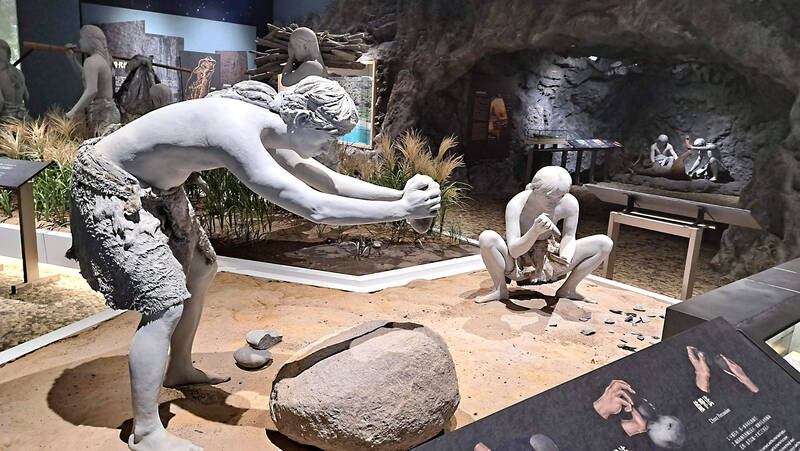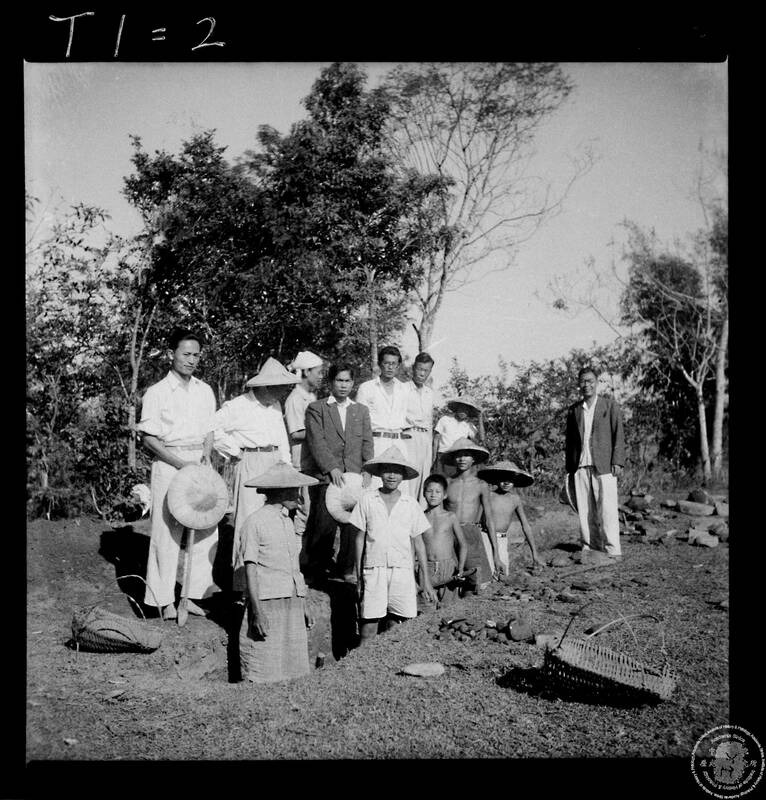Jan. 6 to Jan. 12
Perhaps hoping to gain the blessing of the stone-age hunter-gatherers that dwelt along the east coast 30,000 years ago, visitors to the Baxian Caves (八仙洞) during the 1970s would grab a handful of soil to bring home.
In January 1969, the nation was captivated by the excavation of pre-ceramic artifacts and other traces of human habitation in several caves atop a sea cliff in Taitung County. The majority of the unearthed objects were single-faced, unpolished flake tools fashioned from natural pebbles collected by the shore. While archaeologists had found plenty of neolithic (7,000 BC to 1,700 BC) remains in Taiwan, this was the first time a paleolithic (2.5 million to 11,000 years ago) culture was discovered.

Photo: Huang Ming-tang, Taipei Times
After the first excavations, Lee Chi (李濟), then director of Academia Sinica’s Institute of History and Philology, visited the site on Jan. 8 and named the culture “Changpinian” (長濱文化) after the local township, although most English sources today use “Changbin Culture.”
Since the timeline fit with the last ice age, when the Taiwan Strait was traversable by foot, lead archaeologist Sung Wen-hsun (宋文薰) surmised that these people arrived in pursuit of migrating animals from China. Due to similar sites being found in the Philippines, Vietnam and Indonesia, some also believe that they arrived via sea from Southeast Asia. But due to a lack of human remains, the truth remains murky.
The caves were popular; several thousand years after the first inhabitants left, neolithic farmers arrived and left a trove of artifacts. Recent excavations have shown that iron age peoples also visited, although they did not reside there.

Photo courtesy of Taiwan Cultural Memory Bank
OLDEST HUMANS
Once underwater, the Baxian Caves were formed by sea erosion and pushed upward by tectonic uplift. During the Japanese colonial era, several shrines and altars were set up in several of the caverns, with the largest one in Chaoyin Cave (潮音洞).
On March 4, 1968, National Taiwan University (NTU) geology professor Lin Chao-chi (林朝棨) visited the caves to investigate the soil and rock layers, unexpectedly finding traces of neolithic human habitation. He also found traces of reddish clay, which suggested the existence of older layers underneath, writes Sung in Changpinian: A newly discovered preceramic culture from the agglomerate caves on the east coast of Taiwan (長濱文化 : 臺灣首次發現的先陶文化).

Photo courtesy of National Central Library
Sung happened to be in Taitung at that time, preparing to excavate the megalithic Qilin Culture (麒麟文化). Lin contacted him, and after work on the Qilin Culture was done, Sung brought the entire team to the Baxian Caves on March 27. They agreed it was worth further exploration and requested the county government to grant it protected status, since people were still using the caves. These inhabitants had dug up about three meters of earth in Chaoyin Cave, but fortunately a patch by the entrance remained intact.
Funds finally came down from NTU by the end of the year, and the duo arrived in Taitung on Dec. 26 and began digging, finding by Dec. 30 “irrefutable evidence” of a pre-ceramic cultural layer beneath the reddish clay. As there were no phones on site, Sung rushed to Changbin town and called Lee Chi, whom he refers to as “Taiwan’s leading authority in anthropological archaeology.” Lee arrived with two other experts, Shih Chang-ju (石璋如) and Li Yih-yuan (李亦園), and confirmed that this was the nation’s oldest human discovery.
TWO LAYERS

Photo courtesy of Academia Sinica Institute of History and Philology
The story was a media sensation, with United Daily News reporters being the first to arrive on New Year’s Day. Reports continued throughout the the entire month as the public was enthralled by the discovery, writes Tseng Yu-hsuan (曾于宣) for the National Museum of Prehistory. In addition, tourists started pouring in.
By Jan. 4, a substantial amount of artifacts and traces of human habitation such as ash and food waste were found in three of the caves. Curiously, nothing was found in the deep layer of red soil, indicating that there was at least a 2,000-year gap between the two cultures. One theory states that the caves became uninhabitable after sea levels rose as the glaciers retreated, and were only used again after re-emerging through tectonic activity.
A second excavation took place later that month, focusing on Chaoyin Cave, where the majority of the tools were found. Sung and Lin carried out a total of five digs in seven caves that year, unearthing more than 3,000 paleolithic objects.
The neolithic layer included refined stone hoes, knives, sickles, spears, arrowheads, as well as evidence of pottery and weaving technology. The inhabitants lived there approximately 3,500 to 1,500 years ago were mainly farmers and hunters. Aside from the absence of metal, their lifestyle was similar to the indigenous Taiwanese before modernization, Sung writes.
By contrast, the paleolithic layer yielded no farming tools or arrows, nor pottery or weaving. The team found only crude, mostly flaked stone, as well as bone and antler tools.
A CLEARER PICTURE
After Lin and Sung’s efforts, no further investigation was made into the site until 2008, when National Tsing Hua University’s Tsang Chen-hwa (臧振華) excavated 16 more caves, one rock shelter and one open-air terrace. Tsang was able to offer a clearer picture of human activity, writing in a 2017 publication that the first inhabitants arrived about 30,000 years ago, staying for about 15,000 years. These first peoples consumed little from the sea — subsisting mainly on boar and deer — even though they lived next to it.
Another group stayed there about 6,000 to 4,800 years ago, now possessing the ability to polish and refine their tools. Their lifestyle was similar to the previous group, but they engaged in fishing and collected shellfish. They were relatively few in number and mostly stayed by the shore, Tsang writes, and over the years archaeologists unearthed similar sites along the coast.
The neolithic peoples made the caves their home between 3,500 and 2,000 years ago, and Tsang also found iron age artifacts, including metal jewelry and agate beads from later visitors.
Tsang writes that the exact origin of the Chanbin Culture remains disputed, as similar sites have been found in southern China, the Philippines and Vietnam. In addition to the original theory, he suggests that they could also have been part of the first wave of humans who left Africa and dispersed toward Asia about 60,000 years ago, passing through Southeast Asia and onward to Taiwan, China and even Japan.
Taiwan in Time, a column about Taiwan’s history that is published every Sunday, spotlights important or interesting events around the nation that either have anniversaries this week or are tied to current events.

On April 26, The Lancet published a letter from two doctors at Taichung-based China Medical University Hospital (CMUH) warning that “Taiwan’s Health Care System is on the Brink of Collapse.” The authors said that “Years of policy inaction and mismanagement of resources have led to the National Health Insurance system operating under unsustainable conditions.” The pushback was immediate. Errors in the paper were quickly identified and publicized, to discredit the authors (the hospital apologized). CNA reported that CMUH said the letter described Taiwan in 2021 as having 62 nurses per 10,000 people, when the correct number was 78 nurses per 10,000

As we live longer, our risk of cognitive impairment is increasing. How can we delay the onset of symptoms? Do we have to give up every indulgence or can small changes make a difference? We asked neurologists for tips on how to keep our brains healthy for life. TAKE CARE OF YOUR HEALTH “All of the sensible things that apply to bodily health apply to brain health,” says Suzanne O’Sullivan, a consultant in neurology at the National Hospital for Neurology and Neurosurgery in London, and the author of The Age of Diagnosis. “When you’re 20, you can get away with absolute

May 5 to May 11 What started out as friction between Taiwanese students at Taichung First High School and a Japanese head cook escalated dramatically over the first two weeks of May 1927. It began on April 30 when the cook’s wife knew that lotus starch used in that night’s dinner had rat feces in it, but failed to inform staff until the meal was already prepared. The students believed that her silence was intentional, and filed a complaint. The school’s Japanese administrators sided with the cook’s family, dismissing the students as troublemakers and clamping down on their freedoms — with

As Donald Trump’s executive order in March led to the shuttering of Voice of America (VOA) — the global broadcaster whose roots date back to the fight against Nazi propaganda — he quickly attracted support from figures not used to aligning themselves with any US administration. Trump had ordered the US Agency for Global Media, the federal agency that funds VOA and other groups promoting independent journalism overseas, to be “eliminated to the maximum extent consistent with applicable law.” The decision suddenly halted programming in 49 languages to more than 425 million people. In Moscow, Margarita Simonyan, the hardline editor-in-chief of the